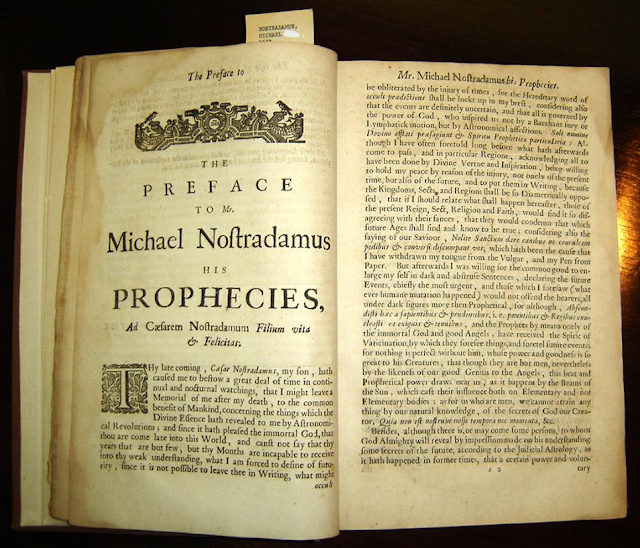Nostradamus.
Michel de Nostredame was born on December 14, 1503 in
France. His family was originally Jewish, but converted to Catholicism. There
is not much known about Nostradamus' childhood other than Jean de St. Remy, his
maternal great grandfather, educated him.
Nostradamus entered the University of Avignon at the age of
15, but was forced to leave a little more than a year later when the outbreak
of the plague caused the University to close its doors. He served as an
apothecary and studied medicine at the University of Montpellier. He was a well
respected healer and even created a pill to help protect people against the
plague. However, it is believed his first wife and two children all died of the
disease in 1534. He traveled extensively after their deaths, finally settling
in Salon, France, where he met and married his second wife, Anne Ponsart
Gemelle.
Nostradamus wrote an almanac in 1550 and continued to write
one each year after that. All in all, the almanacs contained almost 6,400
prophecies. Because of the success of these almanacs, Nostradamus found
nobility, such as the Queen of France, Catherine de Medicis and other
well-known people contacting him for personal horoscope readings.
But it was in 1555 that Nostradamus would write the
document, The Prophecies, which would make him famous. At the age of 52, he
wrote his first set of 100 quatrains. He wrote almost 1,000 quatrains in total,
each using a mixture of Greek, Italian, Latin and Provencal. It is said that
Nostradamus confused the time sequence to prevent being persecuted as a
magician.
Nostradamus was believed to have even predicted his own
death. It was on July 1, 1566 that his priest came to visit. When the priest
left, saying "Until tomorrow," legend has it that Nostradamus said,
"You will not find me alive at sunrise." He died during the night.
Through the years, people
have argued about whether Nostradamus was a prophet or fraud. Were his
quatrains predicting our future or were they so thinly written that they could
have predicted any future? No one will ever know for sure, but even today,
people are looking towards Nostradamus' quatrains for help and guidance.





Comments
Post a Comment